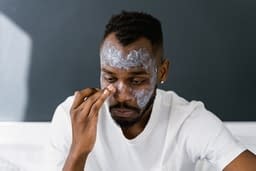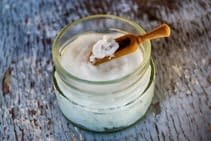Testosterone is a hormone produced in the testicles in males and is responsible for physiological processes like facial hair growth, muscle mass, bone density, and sex drive.
People with low testosterone levels suffer conditions like delayed puberty, patchy beard, no beard, reduced energy, decreased muscle mass, mood changes, and sexual dysfunction.
Doctors recommend using minoxidil,testosterone cream, gels, or boosters along with beard regime in all the above conditions. Here we are going to discuss the usage of testosterone cream for beard growth.
Table of Contents
Testosterone cream for beard growth:
Testosterone cream or gel is a topical medicine for low testosterone levels or hypogonadism, andropause, delayed puberty, and gender transition.

According to the study, when 32 men of age above 15 years with beta‐thalassemia major received 2.5% of testosterone gel, they found improvement in the terminal hairs of the beard area.
Testosterone cream for beard growth can be an effective method to stimulate facial hair growth to some extent. When applied to the skin, it gets absorbed, enters the bloodstream, and stimulates beard growth. However, beard growth also depends on genetics, age, diet, lifestyle, sleep, and stress levels.
In addition, it is crucial to note the effectiveness of testosterone gel for facial hair growth varies among individuals. Also, consult with a doctor before using testosterone cream for beard growth.
Other methods people try are, creatine for beard growth and the best beard growth serums that helps to stimulate facial hair growth.
Does testosterone cream help beard growth?
Testosterone cream may or may not help with beard growth, depending upon individual conditions.

Beard growth depends on genetics, testosterone levels, hormonal balance, age, ethnicity, lifestyle, habits, and stress levels.
An individual who has slow or no beard growth could have any other reason than low testosterone levels.
Testosterone cream or gel can help improve facial hair growth if one has low levels. But one has to work equally on all factors rather than focussing on testosterone for fuller beard growth.
Testosterone cream is a topical medication containing synthetic or bioidentical testosterone that comes in gel or cream forms.
Testosterone and androgens like dihydrotestosterone or DHT are hormones that help to stimulate the growth of facial hair by activating hair follicles.
People who have low testosterone levels due to whatsoever reason face problems like no beards or patchy beards and a lot more.
Testosterone cream can help promote beard growth in individuals with low testosterone levels or insufficient androgenic stimulation.
When applied as a cream or gel and absorbed through the skin, testosterone enters the bloodstream, potentially stimulating hair follicles and fostering beard growth in those who lack sufficient testosterone.
It is vital to seek advice from a healthcare professional before using testosterone cream for beard growth.
They can assess your hormone levels, offer suitable recommendations, and oversee your progress to ensure safety and effectiveness.
Other uses of testosterone cream:
Here are some specific uses of testosterone cream:

Hypogonadism:
Hypogonadism, or low testosterone levels, is a condition that happens due to primary testicular failure or dysfunction of the hypothalamus or pituitary gland in males.
Testosterone cream help to improve deficient testosterone levels and works on factors like libido, fatigue, depression, and loss of muscle mass.
Andropause:
As men age, their testosterone levels naturally decline. Some men experience symptoms associated with this decline, known as andropause or late-onset hypogonadism.
Testosterone cream helps to alleviate symptoms such as reduced energy, decreased muscle mass, mood changes, and sexual dysfunction.
Gender Transition:
Testosterone cream can be a component of hormone therapy for individuals undergoing female-to-male (FTM) gender transition.
It helps promote masculinization, including the development of facial and body hair, deepening of the voice, increased muscle mass, and changes in fat distribution.
Delayed Puberty:
In some cases, testosterone cream help to deal with delayed puberty or inadequate pubertal development.
It can help stimulate the onset of puberty, including the growth of facial and body hair, deepening of the voice, and development of secondary sexual characteristics.
Off-Label Uses:
In certain situations, healthcare professionals may prescribe testosterone cream for off-label uses.
It might include treating certain forms of female sexual dysfunction or addressing specific symptoms associated with testosterone deficiency in women, such as low libido or fatigue.
However, using testosterone cream in women is less common and requires careful evaluation and monitoring.
Choosing the Right Testosterone Cream:
Testosterone cream is the best treatment option for individuals with low testosterone levels or those seeking to enhance beard growth.
However, purchasing testosterone cream requires careful consideration and adherence to safety guidelines.
Here’s a testosterone cream buyer’s guide to help you make an informed decision:
Consult a Healthcare Professional:
Before purchasing testosterone cream, consult a healthcare professional, preferably an endocrinologist or hormone specialist. They will assess your hormone levels, review your medical history, and determine the suitability of testosterone cream.
Prescription Requirement:
Testosterone cream is a prescription medication so you can not purchase it over the counter. Never buy it through sellers or websites offering testosterone cream without a prescription, as this is illegal and potentially unsafe.
Choose the Right Formulation:
Discuss with your healthcare professional which formulation of testosterone cream is most appropriate for your needs. Options include bioidentical and synthetic testosterone creams, as well as different concentrations.
Reputable Pharmacy or Manufacturer:
Purchase testosterone cream from a reputable pharmacy or directly from a trustworthy manufacturer. Never buy it from unknown sources or unverified online sellers to ensure you receive a genuine and safe product.
Read and Follow the Instructions:
When you receive your testosterone cream, carefully read and follow the instructions provided by your healthcare professional and on the product’s packaging. It includes information on application, dosage, and potential side effects.
Monitor Progress and Side Effects:
While using testosterone cream, regularly monitor your progress and any potential side effects. Report any unexpected symptoms to your doctor as soon as possible.
Disbelieve “Miracle” Claims:
Be wary of products that promise unrealistic or quick beard growth outcomes. Testosterone cream can be beneficial, but it is not a magical solution for everyone. Steer clear of products that promise instant results without scientific evidence.
Adhere to Dosage Recommendations:
Stick to the recommended dosage and duration prescribed by your healthcare professional. Avoid using more or less than prescribed to prevent potential side effects or inadequate results.
Be Patient:
Beard growth takes time and varies among individuals. Be patient and give the treatment sufficient time to show its effects. Avoid using excessive amounts of testosterone cream in hopes of faster results.
By following this buyer’s guide and seeking appropriate medical advice, you can make a safe and well-informed decision about using testosterone cream.
How to apply testosterone cream for beard growth?

Testosterone cream is a prescription medicine because it has side effects and is risky on inappropriate usage.
To avoid such risk, I have shared step by step guide to applying testosterone cream:
Wash Hands:
Before applying the testosterone cream, wash your hands with handwash to ensure cleanliness.
Cleanse Skin:
Clean the area you are going to apply the cream. Common application sites include the inner thighs, shoulders, upper arms, or abdomen. Avoid areas with cuts, bruises, or skin irritation.
Check Dosage:
Measure the dosage of testosterone cream as prescribed by your doctor. Some creams come with a pre-measured pump, while others may require specific measurements using an applicator or syringe.
Apply Cream:
Squeeze the appropriate amount of cream onto your fingertips or the applicator, then apply it to the chosen skin area.
Gently massage the cream in a circular motion until it is fully absorbed.
Rotate Application Sites:
Rotate the application sites daily to prevent skin irritation and ensure consistent absorption.
Avoid Contact:
After applying the cream, avoid contact with others, especially women and children, until the skin is dry. Testosterone can easily get transferred to others through skin contact and may cause unwanted side effects.
Clean Hands again:
Wash your hands thoroughly after applying the testosterone cream to prevent accidental transfer to other areas of your body or objects.
Dry the areas:
Let the testosterone cream be absorbed and dry before covering the skin with clothing. It typically takes a few minutes.
Follow the Dosage Schedule:
Stick to the prescribed dosage schedule as instructed by your healthcare professional. Avoid using more or less than recommended.
Monitor Progress:
Regularly monitor your progress and discuss any concerns or changes with your healthcare professional during follow-up appointments.
If you have any questions or uncertainties about the application process, seek clarification from your healthcare provider or pharmacist to ensure proper usage and optimal results.
How much testosterone cream per day?
The appropriate daily dosage of testosterone cream depends on factors like age, hormone levels, and the specific product used.
Your healthcare professional will determine the correct dosage after evaluating your hormonal profile and devising a treatment plan tailored to your needs.
Testosterone creams are available in various strengths or concentrations, and your healthcare provider will provide dosing instructions. Generally, dosages include 1%, 1.62%, and 2%.
For example, consider the following commonly prescribed dosages:
- 1% testosterone cream: The recommended dosage may range from 50 to 100 milligrams (mg) of testosterone (equivalent to 1/2 to 1 gram of cream) applied once daily.
- 1.62% testosterone cream: The recommended dosage may be approximately 20.25 milligrams (mg) of testosterone (about 1.25 grams of cream) applied once daily.
It is essential to strictly adhere to the dosage instructions given by your healthcare professional and those on the product’s packaging. Never take extra testosterone dosage without consulting your doctor. Wrong dosing can lead to adverse effects or reduced treatment efficacy.
Side effects of testosterone gel for facial hair growth:

While testosterone cream can provide benefits for some individuals, it is essential to be aware of potential side effects that may arise.
The specific side effects can vary from person to person and may depend on factors such as dosage, duration of use, individual response, and overall health.
Here are some possible side effects associated with testosterone cream:
Skin Reactions:
Common side effects of testosterone cream include skin reactions at the application site, such as redness, itching, irritation, or a rash.
Proper application techniques and patch tests are crucial before applying testosterone cream.
Also, avoid contact with others, particularly women and children, should be avoided to prevent unintended effects from testosterone transfer.
Hormonal Imbalances:
Testosterone cream can disrupt the hormonal balance in the body, leading to side effects like increased acne, oily skin, or worsening of existing skin conditions.
It may also affect the natural production of hormones, potentially suppressing the body’s testosterone production.
Mood Changes:
Some individuals may experience mood swings, irritability, or behavioral changes while using testosterone cream.
They may face heightened aggression, mood fluctuations, or increased emotional sensitivity. Consulting a healthcare professional is essential if these effects become severe or persistent.
Fluid Retention:
Testosterone cream can cause fluid retention in some individuals, resulting in swelling or edema in the extremities.
Prostate Effects:
Testosterone can stimulate the growth of prostate tissue, which may lead to an enlargement of the prostate gland (benign prostatic hyperplasia).
Regular monitoring of prostate health is crucial, especially for those with pre-existing prostate conditions, while using testosterone cream.
Cardiovascular Risks:
It may enhance the chances of cardiovascular risks associated with testosterone therapy, including an increased risk of heart attacks, strokes, or blood clot formation.
However, the evidence regarding these risks remains inconclusive and subject to ongoing research.
How to get testosterone naturally?

Opting for natural methods is advisable when considering your health. Making lifestyle changes can also help enhance testosterone levels, which has fewer risks as compared to topical testosterone gel for promoting facial hair growth.
Here are some strategies to help boost testosterone naturally:
Maintain a Healthy Diet:
Consume a balanced diet rich in nutrient-dense foods. Add fruits, vegetables, whole grains, lean proteins, and healthy fats in your diet.
Adequate zinc, vitamin D, and omega-3 fatty acids are vitamins and minerals that improve testosterone levels, so focus on foods like seafood, nuts, seeds, eggs, and fortified dairy products.
Regular Exercise:
Engage in regular physical activity and incorporate both aerobic exercises (e.g., running, swimming) and resistance training (e.g., weight lifting) into your routine.
High-intensity interval training (HIIT) has also shown potential benefits for testosterone levels.
Manage Stress:
Chronic stress can negatively impact hormone levels, including testosterone.
Practice stress-reduction techniques such as meditation, yoga, deep breathing exercises, or spend time in nature to promote relaxation.
Get Adequate Sleep:
You need 7-9 hours of quality sleep per night. Poor sleep can disrupt hormonal regulation and lower testosterone levels.
Try to sleep at least 8 hours daily.
Maintain a Healthy Weight:
Excess body fat, especially around the belly, might suppress testosterone levels. Maintaining a healthy weight through a balanced diet and regular exercise can help support hormonal balance.
Limit Alcohol Consumption:
Excessive alcohol intake can negatively impact testosterone production. Moderation is key, and it’s essential to limit alcohol consumption to promote hormonal health.
Avoid Endocrine Disruptors:
Certain chemicals in plastics, personal care products, and pesticides can act as endocrine disruptors, interfering with hormonal balance. Try to minimize exposure to these substances.
Sun Exposure:
Spend time in the sun to ensure adequate vitamin D levels. Vitamin D deficiency is linked with lower testosterone levels.
Consider Herbal Supplements:
Some herbal supplements like ashwagandha, fenugreek, and tribulus terrestris can support male reproductive health.
However, their effectiveness may vary among individuals, and it’s essential to consult a healthcare professional before using these supplements.
Check Medications:
Certain medications can affect testosterone levels. If you’re concerned about your testosterone levels, discuss with your doctor whether any medicine exaggerating the issue.
Remember, natural methods may or may not lead to significant changes in testosterone levels for everyone.
If you feel you have low testosterone or are suffering signs of low testosterone, it would be wise to speak with a healthcare expert.
They can conduct appropriate tests, diagnose underlying issues, and provide personalized recommendations for managing testosterone levels based on your specific health needs.
Conclusion:
Testosterone cream for beard growth is a prominent remedy to improve facial hair growth, especially if dealing with low testosterone levels.
Testosterone gel for facial hair growth requires doctor consultation before application as it may lead to several risks.
They will check your medical history, health needs, and appropriate tests, then recommend the particular testosterone cream with a dosage limit.
Never buy testosterone cream through sellers or websites offering it without a prescription, as this is illegal and potentially unsafe.
FAQs:
Does testosterone gel work for a beard?
Testosterone gel may promote beard growth in individuals with low testosterone levels or insufficient androgenic stimulation. When applied topically, it can potentially stimulate hair follicles and aid in beard development, but results may vary depending on individual factors. Consulting a healthcare professional is crucial before use.
Can I apply testosterone cream at night?
Certainly! Testosterone cream is suitable for the nighttime application, with the timing determined by the specific product and healthcare professional’s instructions. Applying at night helps maintain stable hormone levels and minimizes accidental transfer to others, ensuring safety and effectiveness.
Kayden is an entrepreneur, writer, hairstylist working in a professional salon. He specializes in men’s grooming. He loves to blog about beards, hairstyles, and skincare.
